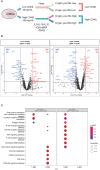Differential response of IgM and IgG memory B cell populations to CD40L: insights of T cell - memory B cell interactions
- PMID: 39050849
- PMCID: PMC11266000
- DOI: 10.3389/fimmu.2024.1432045
Differential response of IgM and IgG memory B cell populations to CD40L: insights of T cell - memory B cell interactions
Abstract
Memory B cells (mBCs) are characterized by their long-term stability, fast reactivation, and capability to rapidly differentiate into antibody-secreting cells (ASCs). However, the role of T cells in the differentiation of mBCs, in contrast to naive B cells, remains to be delineated. We study the role of T cells in mBC responses, using CD40L stimulation and autologous T-B co-cultures. Our results showed that increased CD40L levels led to a selective increased proliferation of IgM+ mBC, which did not class-switched, resulting in higher frequencies of IgM+ ASCs and a lower frequency of IgG+ ASCs. The IgG+/IgA+ mBCs were unaffected. We further compared the transcription of immune-related genes in IgM+ and IgG+ pre-plasmablasts cultured at high (500 ng/mL) and low (50 ng/mL) CD40L levels. In response to increased CD40L levels, both populations exhibited a core response to genes related to activation (TRAF1, AKT3, CD69, and CD80). However, they differed in genes related to cytokine/chemokine/homing interactions (CCL3/4/17, LTA, NKX2-3, BCL2 and IL21R) and cell-cell interactions (HLADR, CD40, and ICOSL), which were largely confined to IgG+ cells. Our findings revealed that in co-cultures with a high T-ratio, the response was similar to that found in cultures with high CD40L levels. These results suggest that IgG+ mBCs have a greater capacity for proliferation and T cell interaction, and weaker migration capabilities, leading to a preference for an IgG response over IgM in the short term. This adaptable response could fine-tune the memory repertoire with different functions of IgG versus IgM mBCs.
Keywords: CD40L; T:B co-stimulation; memory B cell; plasma cell; plasmablast.
Copyright © 2024 Rincon-Arevalo, Stefanski, Le, Cases, Wiedemann, Szelinski, Ritter, Dang, Lino, Dörner and Schrezenmeier.
Conflict of interest statement
The authors declare that the research was conducted in the absence of any commercial or financial relationships that could be construed as a potential conflict of interest.
Figures






References
-
- Chappert P, Huetz F, Espinasse MA, Chatonnet F, Pannetier L, Da Silva L, et al. . Human anti-smallpox long-lived memory B cells are defined by dynamic interactions in the splenic niche and long-lasting germinal center imprinting. Immunity. (2022) 55:1872–90.e9. doi: 10.1016/j.immuni.2022.08.019 - DOI - PMC - PubMed
MeSH terms
Substances
LinkOut - more resources
Full Text Sources
Research Materials
Miscellaneous

